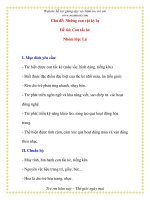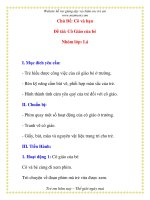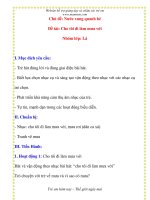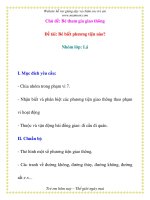121 CHƯƠNG TRÌNH hỗ TRỢ 2k1,2k2,2k3 CHỦ đề HOME LIFE (KEYS)
Bạn đang xem bản rút gọn của tài liệu. Xem và tải ngay bản đầy đủ của tài liệu tại đây (566.95 KB, 9 trang )
CHƯƠNG TRÌNH HỖ TRỢ 2K1,2K2,2K3
(CHỦ ĐỀ HOME LIFE)
Compiled by Mrs Trang Anh
Facebook: Mrstranganh87
I. Read the passage below and choose one correct answer for each question:
AMERICAN FAMILY
Belonging to a family is one bond almost everyone in the world shares, but family patterns
vary from country to country. The United States has many different types of families. While most
American families are traditional, comprising a father, mother and one or more children, 22.5
percent of all American families in 1983 were headed by one parent, usually a woman. In a few
families in the United States, there are no children. These childless couples may believe that they
would not make good parents; they may want freedom from the responsibilities of child-rearing; or,
perhaps they are not physically able to have children. Other families in the United States have one
adult who is a stepparent. A stepmother or stepfather is a person who joins a family by marrying a
father or mother.
Americans tolerate and accept these different types of families. In the United States, people
have the right to privacy and Americans do not believe in telling other Americans what type of
family group they must belong to. They respect each other’s choices regarding family groups.
Families are very important to Americans. One sign that this is true is that Americans show
great concern about the family as an institution. Many Americans believe there are too many
divorces. They worry that teenagers are not obeying their parents. They are concerned about
whether working women can properly care for their children.
Families give Americans a sense of belonging and a sense of tradition. Families give Americans
strength and purpose.
Families serve many functions. They provide a setting in which children can be born and
reared. Families help educate their members. Parents teach their children values - what they think
is important. They teach their children daily skills, such as how to ride a bicycle. They also teach
them common practices and customs, such as respect for elders and celebrating holidays. The most
important job for a family is to give emotional support and security.
1. How many types of families exist there in the USA?
A. Two
B. Three
C. Four
D. Five
2. What is the attitude of Americans to the types of family groups?
A. permissive
B. disagreeable
C. careless
D. reckless
3. Why is a family important to Americans?
A. Because marriage is not easy in America
B. Because family is the best place for them to live in
C. Because only women in families are able to care for their children well
D. Because family gives them strength and purpose
4. Why do some couples prefer to be childless?
A. They accept that they would not make good parents
B. They don’t want to have responsibilities for childcare
C. They are not physically able to have children.
D. All of the above
5. What sense do families give to Americans?
A. a sense of freedom and a sense of jewellery
B. a sense of belonging and a sense of
tradition
C. a sense of belonging and a sense of wonder
D. a sense of humour and a sense of tradition
6. What functions do families serve?
A. habitat and food
B. money and life skills
C. emotional support and security
D. joyfulness and daily supplies
II. Read the passage below and choose one correct answer for each question:
HAPPY FAMILY
A family can be two or more people who share goals and values, have long-term commitments
to one another, and usually live in the same house. Families range from all sorts of races, forms and
sizes. Families differ in various ways but each one has its own definition of a happy home and
family. So, what makes a happy family? There are many important factors that make a happy family.
Order is one of the important factors that make a happy family. With order there is no chaos
or confusion in the home. A well-organized family will be able to function smoothly and easily in
completing various tasks that each individual must do. When each individual knows his/her own
responsibility, he/she is capable and able to bring more harmony and peace in the home.
Quality time is definitely one aspect to having a happy family. This quality time spent together
as a family no matter what the activity is will surely strengthen a family’s relationship. Quality time
helps to develop a bond between family members. Not only will this strengthen ties, it will provide
you with charitable memories of times spent together, whether it is having fun, being sad, happy, or
bad.
In addition, a happy family must have an open communication between each individual. It is
important that each member of the family is heard, either it be about a problem, sharing good news
or just because that person is there. Everyone is important enough to have their own opinion. An
open communication between parents and their children will help increase trust and decrease the
problems of drug and alcohol abuse, teen pregnancy and crime. Also an open communication
between a husband and wife will bring much understanding, appreciation, trust and much more.
Being “open” with each other is something that is essential in a happy family, but may be very hard
to do. Discussing our feelings amongst each other can help us to have a stronger bond.
1. How many important aspects are there for each family to become a happy family?
A. One
B. Two
C. Three
D. Four
2. If every members in the family knows his/her own duty, _______.
A. He/She is incapable of doing well with others.
B. He/She is able to bring more safety and harmony in the home.
C. He/She can be a good member of his/her family.
D. He/She can complete various tasks in his/her own family.
3. The word “crime” in paragraph 3 mostly means ______.
A. felony
B. guilty
C. shame
D. innocence
4. All of the following are true EXCEPT ______.
A. If family is well organized, there is no chaos or confusion in the home.
B. Family memebers have many memories of time together.
C. Quality time strengthen ties between family members.
D. All of the members live in the same house or not.
5. Being “open” can be undertood as _______.
A. empathy
B. private
C. separate
D. mutual
6. A husband and wife having an open communication will ______.
A. bring much understanding, appreciation, trust and much more.
B. help increase trust and decrease the problems of drug and alcohol abuse.
C. bring more harmony and peace in the home.
D. be very hard to discuss their feelings.
III. Read the passage below and choose one correct answer for each question:
NUCLEAR FAMILY
The traditional definition of a nuclear family is a family unit that includes two married parents
of opposite genders and their biological or adopted children living in the same residence. However,
the term “nuclear family” can mean several different things in today’s society. Understanding the
classic roles in this type of family and how it is defined can help you understand the relationships in
your own family, whether it’s nuclear or not.
According to the Merriam-Webster Dictionary, the term “nuclear family” was first used in
1947, but the concept of a family that consists of just parents and children is much older. This basic
unit of a family’s structure has existed for millennia, but it wasn’t until the 1960s and 1970s that
the nuclear family became the majority situation. At that time, industrial economic booms and
rising wages made it possible for young parents to afford their own homes without living with
extended family members. At the same time, better healthcare contributed to the nuclear family, as
elderly members became more self-sufficient and independent for decades after their children
were grown.
Today, the era of the nuclear family is often glamorized, complete with mom in the kitchen,
dad out earning the paychecks, and the kids building a tree house or hosting a stuffed animal tea
party. In reality, there is no ideal type of family, and today’s definition of a nuclear family can
greatly differ from that it was a few decades ago.
1. Nuclear family is ______.
A. a family that includes not only parents and children but also other relatives.
B. a family that includes only the father, mother, and children.
C. a family that includes a person’s parents, spouse, children and siblings.
D. a family that includes children from a previous marriage of the wife, husband, or both parents.
2. When was the term “nuclear family” officially used?
A. in 1947
B. in 1960
C. in 1970
D. until the 1960-1970
3. The word “millennia” in paragraph 2 means ______.
A. 200 years
B. 500 years
C. about 10000 years
D. about 1000 years
4. According to the passage, which of the following statements is not true?
A. The children should take care of their elderly members after they are grown.
B. The nuclear family didn’t become the majority situation until the 1960s and 1970s.
C. Understanding the roles in nuclear family helps you understand the relationships in your family.
D. Young parents afford their own homes because of industrial economic booms and rising wages.
5. The word “glamorized” in paragraph 3 mostly means ______.
A. unexpected
B. disclaimed
C. desirable
D. admirable
6. What do we need for a nuclear family?
A. Mother takes the responsibility for running the household.
B. Father brings home money earned at a job.
C. The children play around the house.
D. All of the above
IV. Read the following passage and choose the best answer for each blank.
INTERNATIONAL DAY OF FAMILIES
The International Day of Families is observed (1)______ the 15th of May every year. The Day
was proclaimed by the UN General Assembly in 1993 and reflects the (2)______ the international
community attaches to families. The International Day provides an opportunity to promote
awareness of issues relating to families and to increase knowledge of the social, (3)______ and
demographic processes affecting families.
The International Day of Families has inspired a series of awareness-raising events, (4)______
national family days. In many countries, that day provides an opportunity to highlight different
areas of interest and importance to families. (5)______ include workshops and conferences, radio
and television programmes, newspaper articles and cultural programmes highlighting relevant
(6)______.
The central goals of the 2030 Agenda for Sustainable Development (7)______ ending poverty,
promoting shared economic prosperity, social development and people’s well-being while
protecting the environment. Families remain at the centre of social life ensuring the well-being of
their members, educating and socializing children and youth and caring for young and old.
(8)______, family-oriented policies can contribute (9)______ the achievement of Sustainable
Development Goals 1 to 5 relating to (10)______ with poverty and hunger; ensuring healthy lives and
promoting of well-being for all ages; ensuring educational opportunities throughout the lifespan
and achieving gender equality.
1.
A. in
B. on
C. at
D. by
2.
A. import
B. important
C. importantly
D. importance
3.
A. economy
B. economic
C. economics
D. economical
4.
A. including
B. include
C. includes
D. including of
5.
A. Actualities
B. Actions
C. Activities
D. Activenesses
6.
A. melodies
B. themes
C. rhymes
D. chapters
7.
A. depend on
B. rely on
C. focus on
D. go on
8.
A. In total
B. In all
C. In advance
D. In particular
9.
A. to
B. for
C. of
D. with
10.
A. going down
B. go down
C. doing away
D. do away
V. Read the following passage and choose the best answer for each blank.
A nuclear family or elementary family is a family group (1)______ a pair of adults and their
children. It is in contrast to a single-parent family, to the larger extended family, and to a family
with more than two parents. Nuclear families typically centre on a (an) (2)______ couple; the nuclear
family may have any number of children. There are differences in definition among observers; some
definitions allow only biological children that are full-blood siblings, but (3)______ allow for a
stepparent and any mix of dependent children including stepchildren and adopted children.
Family structures of one married couple and their children (4)______ in Western Europe and
New England in the 17th century, influenced (5)______ church and theocratic governments. With the
emergence of proto-industrialization and early capitalism, the nuclear family became a financially
viable social unit. The term nuclear family first (6)______ in the early twentieth century. Alternative
definitions have evolved to include family units headed by same-sex parents and perhaps
additional adult relatives who (7)______ a cohabiting parental role; in the latter case, it also receives
the name of conjugal family.
The concept that a narrowly defined nuclear family is central to (8)______ in modern society
has been promoted by familialists who are social conservatives in the United States, and has been
challenged as historically and sociologically inadequate (9)_____ the complexity of actual family
relations.
As a fertility factor, single nuclear family households generally have a higher number of
children than co-operative living arrangements according (10)_____ studies both from the Western
world and India.
1.
A. consisting
B. consists of
C. consisting of
D. including of
2.
A. married
B. dating
C. divorced
D. estranged
3.
A. other
B. others
C. the other
D. the others
4.
A. had presented
B. presented
C. were present
D. were presented
5.
A. with
B. by
C. for
D. of
6.
A. had appeared
B. have appeared
C. appears
D. appeared
7.
A. take on
B. take up
C. take in
D. take at
8.
A. stability
B. stabilize
C. stabilizer
D. stable
9.
A. describe
B. to describe
C. describing
D. described
10.
A. as
B. on
C. in
D. to
VI. Read the following passage and choose the best answer for each blank.
Life is filled with challenges. As we get older we come to realize that those challenges are the
very things that shape us and make us who we are. It is the same with the challenges that come
with friendship.
When we are faced with a challenge, we usually have two (1)______ . We can try to beat it off, or
we can decide that the thing (2)______ the challenge isn’t worth the (3)______ and call it quits.
Although there are certainly times when calling it quits is the right thing to do, in most (4)______ all
that is needed is commitment and communication.
When we are committed to something, it means that no matter how (5)______ or how
uncomfortable something is, we will always choose to face it and work it through instead of running
away from it. Communication is making a space for discussion and talking about how you feel as
opposed to just saying what the other person did wrong. (6)______ you can say to a friend, “I got my
feeling hurt”, (7)_____ “You hurt my feelings”, you are going to be able to solve the problem much
faster.
In dealing with the many challenges that friendship will bring to you, try to see them for (8)
they are: small hurdles you need to jump or get through on your way through life. Nothing is so big
that it is (9)_____ to get over, and hurt only serves to make us stronger. It is all part of growing up, it
(10)______ to everyone, and some day you will look back on all of this and say, “Hard as it was, it
made me who I am today. And that is a good thing”.
1.
A. opportunities
B. expectations
C. choices
D. aspects
2.
A. presenting
B. predicting
C. deserving
D. demanding
3.
A. expense
B. trouble
C. loss
D. comment
4.
A. cases
B. fields
C. parts
D. occasions
5.
A. doubtful
B. shameful
C. harmful
D. painful
6.
A. If
B. As
C. While
D. Unless
7.
A. or else
B. or rather
C. rather than
D. other than
8.
A. who
B. what
C. which
D. where
9.
A. necessary
B. unnecessary
C. possible
D. impossible
10.
A. appeals
B. opens
C. happens
D. goes
VII. Put each verb in brackets into a suitable past tense:
The Little Girl and the Wolf
One afternoon a big wolf (1. wait)_______ in a dark forest for a little girl to come along carrying
a basket of food to her grandmother. Finally a little girl did come along and she (2. carry)______ a
basket of food. “Are you carrying that basket to your grandmother?” asked the wolf. The little girl
said yes, she was. So the wolf (3. ask)______ her where her grandmother lived and the little girl (4.
tell)______ him and he (5. disappear)______ into the wood.
When the little girl (6. open)______ the door of her grandmother’s house she (7. see)______ that
there was somebody in bed with a nightcap and nightgown on. She (8. approach)______ no nearer
than twenty-five feet from the bed when she (9. see)_____ that it was not her grandmother but the
wolf, for even in a nightcap a wolf does not look in the least like anybody’s grandmother. So the
little girl (10. take)______ an automatic pistol out of her basket and (11. shoot)______ the wolf dead.
(Moral: It is not so easy to fool little girls nowadays as it used to be.)
James Thurber: Fables for Our Time
*KEY
1. waited
2. was carrying
3. asked
4. told
5. disappeared
6. opened
7. saw
8. had approached
9. saw
10. took
11. shot
VIII. Read the passage carefully and choose the correct answer.
Jean spent her first few years in Hooper and her family moved to Otsego early in her life. She
was only ten when her father died unexpectedly, leaving her mother to raise and support their
family alone. Her mother soon went to work outside the home to provide for the family, and Jean,
being one of the oldest, had to help care for her younger siblings. Although she had much
responsibility at home, Jean thoroughly enjoyed school and was an excellent student. She went on
to graduate 10th in her class at Otsego High School in 1953.
While still in high school, Jean met a young man named Charles "Chuck" Holly, at a dance in
Alamo; and they were quite taken with each other. Over the next few years, their love for each other
blossomed and they were married on February 24, 1953, while Jean was still in school. At the time,
Chuck was serving his country in the military, and had come home on leave to marry his
sweetheart. Unfortunately, shortly thereafter, he was sent overseas to serve in Korea for the next
fifteen months.
Upon his discharge, the couple settled into married life together in the Plainwell, Otsego area.
To help make ends meet, Jean went to work at the collection bureau in Kalamazoo for a while,
before taking a job at the cheese company in Otsego. In 1964, Chuck and Jean were overjoyed with
the birth of their son, Chuck, who brought great joy into their lives. Jean remembered how her
mother was always gone so much working after her father died and she did not want that for her
son, so she left her job to devote herself to the role of a mother.
1. Before Jean's father passed away, her mother used to _______.
a. work outside the home
b. be a housewife
c. support the family alone
d. work as a secretary
2. Which is not referred to Jean?
a. She was a responsible girl.
b. She never helped her mother with household chores.
c. She often did well at school. '
d. She went to high school.
3. Jean's husband was a _______.
a. teacher
b. dancer
c. soldier
d. servant
4. Jean _______.
a. served in the military
b. lived in Korea for fifteen months
c. had a daughter
d. got married when she was a student
5. Which is not true about Jean?
a. She disliked staying at home and taking care of her child.
b. She worked outside the home before she had a child.
c. She was very happy when she got a baby.
d. She quit her job to look after her baby.
IX. Fill in each numbered blank with one suitable word or phrase.
There are many reasons (1) _____ taking regular time with our family is important:
It (2) _____ a place to listen, teach, learn, and (3) _____ ourselves freely and safely.
It provides (4) _____ to discuss family joys, issues, and problems.
Family members can practice skills in a non-threatening (5) _____.
Families are a (6) _____ part of our society and the fabric of our communities - we spend (7) _____
time together to get our feelings (8) _____ belonging, our values, support and understanding.
It helps (9) _____ family members together and feel safe in today's world where (10) _____ can lead to
family disintegration
1. a. that
b. why
c. when
d. which
2. a. creates
b. invents
c. develops
d. makes
3. a. think
b. show
c. express
d. say
4. a. opportunities
b. conditions
c. situations
d. circumstances
5. a. air
b. nature
c. space
d. atmosphere
6. a. attractive
b. real
c. deep
d. basic
7. a. a
b. an
c. the
d. no article
8. a. in
b. of
c. on
d. for
9. a. keep
b. keeping
c. kept
d. with keeping
10. a. push
b. press
c. pressure
d. pull
X. Read the passage carefully and choose the correct answer.
Every family has its quirks. Mine is no different. I was born in an Italian- American family in 1973.
We follow the classic stereotype. My father works and my mother stays home with the kids. There
are certain things that we remember from our childhood: phrases, jokes, movies. But one piece of
advice that sticks with me from an early age comes from my mother.
"Don't finish your food or you will never get married." It was an illogical jump from the idea that a
"lady" is not a glutton and therefore will not finish the food on her plate or take the last cookie off of
the platter. A "lady" especially a young lady must never appear hungry. If she did, she would not be
an ideal candidate for a wife.
To this day, I do not finish what is on my plate and I will never eat the last of anything.
It is not a conscience thing. When 1 think about it, 1 make a point to finish the food on my plate,
there is still some teenage rebellion against mom in this thirty-four year-old body, but the thought
of not finishing is so ingrained that I rarely think about it.
When my husband and I are at dinner, he will gesture to something on the table and say, "Finish
your food" and 1 will respond, "I can't, I'll never get married." That always makes him laugh and
say, "So what have these last six years been?" But for me it is something special that I will carry
around with me - something that is my family. My brother remembers the phrase and he admits
that in his dating days he did watch to see if any of the girls would take the last piece of pie or pizza.
I think he fell in love with his fiancé because she would eat whatever she wanted to and do not
worry about anyone judging her for it. As I embark on starting my own family, I wonder what I will
tell my daughter. Will I encourage her to finish every last piece? Or will I continue to the legacy of
my mother and tell her not eat the last piece lest she not get married? Will she one day laugh to her
girlfriends about her mother leaving one granola bar, one piece of cheese, or one rice cake alone in
their bags?
1. The writer's mother never let her eat the last piece of food on her plate.
a. True
b. False
c. No information
2. All the mothers in the world never let their daughter eat the last piece of food on their plate.
a. True
b. False
c. No information
3. The writer often eats up all she has on her Plate and up to now she is still single.
a. True
b. False
c. No information
4. The writer does not believe in what her mother has said but she considers her mother's words
something special.
a. True
b. False
c. No information
5. The writer has two sons.
a. True
b. False
c. No information
XI. Fill in each numbered blank with one suitable word or phrase.
On December 10, 2006, I was going through some hard time. The landlady did not want to release
the house any more so I had to (1) _____ and only had one month to find a place. Because Christmas
was coming and it was difficult for me to (2) _____ a suitable accommodation. I had only some
money (3) _____. I could not buy a Christmas tree and some presents for my three boys, (4) _____ I
had to use the money to find a place to live. Tome, it broke my heart as I could not prepare the
Christmas for my three boys. I have been their only parent since my husband (5) _____ away two
years ago. I was so sad and everything was getting on my nerves. Although I managed to solve the
problem myself I could not help (6) _____ my sons about the things. When I suddenly woke up at
midnight, I found my eldest son was sitting (7) _____me. He kissed me and said, "Don't worry, Mum.
We love you very much and always stand by you (8) ____ happens." At the moment I started
weeping, grabbed him and kissed him. His words and love made me (9) _____ all about what I was
stressing about.
In fact ever since that moment, I have realized that I can overcome any problems thanks to my sons'
love. The most important thing of my life is that my boys are safe and healthy, and they bring me joy
all the time. The memory (10) _____ me that nothing really matters, when I have the love of my
children.
1.
a. transfer
b. convert
c. move
d. change
2.
3.
4.
5.
6.
7.
8.
9.
10.
a. notice
a. leave
a. because
a. passes
a. tell
a. by
a. whenever
a. forget
a. remembers
b. watch
b. to leave
b. although
b. passed
b. to tell
b. next
b. whatever
b. to forget
b. minds
c. find
c. leaving
c. as though
c. has passed
c. told
c. over
c. whoever
c. forgot
c. reminds
d. see
d. left
d. if
d. was passing
d. telling
d. up
d. however
d. forgetting
d. misses









